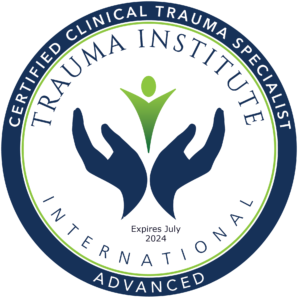Psychological therapy for Disassociative Disorders
Disassociative disorders are conditions where the sufferer disassociates for periods of time. What this means in basic terms is they mentally “switch off” or “blank” in a way that may either appear to be day dreaming, or which may just resemble a silent few moments. In more severe cases two other presentations may occur: disassociating into a different personality, or with a loss of consciousness. These disorders are closely related to complex trauma.
Dissociation is a mental process that involves a disconnection from one’s thoughts, feelings, memories, or sense of self. It can range from mild detachment to severe disruptions in identity and consciousness. Dissociation is often a response to trauma, serving as a coping mechanism to protect the individual from overwhelming experiences.
Here’s how dissociation can manifest with trauma:
1. Depersonalization:
- Feeling detached from oneself: Individuals may feel as if they are observing themselves from outside their body or as if they are in a dream.
- Emotional numbing: They may experience a sense of emotional numbness or detachment from their feelings.
- Distorted perceptions: Their perceptions of the world around them may feel altered or unreal.
2. Derealization:
- Feeling detached from the environment: Individuals may feel as if the world around them is unreal, dreamlike, or distorted.
- Loss of familiarity: Familiar places or people may feel unfamiliar or strange.
- Sensory distortions: They may experience changes in their sensory perceptions, such as blurred vision or muffled sounds.
3. Dissociative Amnesia:
- Memory gaps: Individuals may have difficulty remembering specific events, periods of time, or personal information, especially those related to the trauma.
- Dissociative fugue: In rare cases, individuals may experience dissociative fugue, where they travel or wander with an inability to recall their past, sometimes even assuming a new identity.
4. Dissociative Identity Disorder (DID):
- Multiple identities: DID, formerly known as Multiple Personality Disorder, involves the presence of two or more distinct identities or personality 1 states within an individual.
- Switching between identities: These identities may have different names, ages, genders, and ways of interacting with the world, and the individual may switch between them involuntarily.
- Memory gaps: Individuals with DID often experience significant memory gaps and may not be aware of the other identities.
Why Dissociation Occurs with Trauma:
Dissociation is often a response to overwhelming trauma, serving as a way to:
- Escape the pain: It can provide a temporary escape from the overwhelming emotions and sensations associated with trauma.
- Protect the self: It can protect the individual from the full impact of the trauma, preventing further psychological damage.
- Cope with overwhelming experiences: It can be a way to cope with experiences that are too difficult to process or integrate at the time.
Treatment Considerations:
- Trauma-informed approach: Addressing dissociation in the context of trauma requires a trauma-informed approach that prioritizes safety, empowerment, and respect for the individual’s experiences.
- Therapy: Trauma-focused therapies, such as EMDR or Trauma-Focused CBT, can help individuals process trauma and reduce dissociative symptoms.
- Grounding techniques: Grounding techniques can help individuals stay present and connected to their bodies and the environment.
- Integration: In cases of DID, therapy may focus on integrating the different identities into a cohesive sense of self.
If you or someone you know is experiencing dissociation related to trauma, seeking professional help from a qualified mental health professional is crucial. They can provide appropriate assessment, diagnosis, and treatment to help manage dissociation and improve overall well-being.
Short blank disassociations
This is the most likely version to be seen, the person reacts to stress or an anxiety trigger by “being elsewhere”. it can also be the result of a flash back being triggered where a historical event is being recalled. The person may appear inattentive, distance, and seem to be ignoring you. This can lead to misunderstanding, conflict and accusations of laziness or inattention, especially in adolescents in education or when it occurs in the workplace. Depending on whether a task is under way at the time, it is possible for this task to be interrupted for a moment, or even, for example, for a cup of tea being made to be split or dropped.
It should be noted that it is very hard to tell these short blanks apart from epileptic “absence” seizures and it is important to discuss them with your medical doctor and not assume they are psychological in nature. It should be remembered however that it is more usual for psychological disassociation to be misdiagnosed as epilepsy.
Personality change disassociation
In more severe cases the personality of the sufferer undergoes a change in the disassociated state and a person may appear to have changed in their behaviour, attitude and even in what they believe and remember. What occurs in this state may not be remembered afterwards. This is classified as DID or Disassociative Identity Disorder. This is usually identified where there is a loss of memory or time. DDNOS or Disassociative Disorder Not Otherwise Specified does not have the loss of memory or time, but character and personality can still change as the “parts” within the person exercise control.
It is a matter of debate whether this is related to schizophrenia or not, with some sufferers of disassociation adamant that it is a different condition entirely, and some sufferers of schizophrenia claiming that their condition is itself a form of disassociation.
Loss of consciousness disassociation
Often called Non Epileptic Attack Disorder (NEAD) or pseudo-epilepsy, this is the ultimate disassociation response. The person will loss consciousness and will often shake or spasm as one would expect to see in epilepsy. NEAD is often initially misdiagnosed as epilepsy.
Most people are aware of flight and fight responses to danger. The third response however is that seen in the humble possum. The person loses consciousness, lies still playing dead, the body is flooded by natural pain killers, and for the predator the sufferer / possum appears to be a long dead and unpalatable prey. This state is often associated with loss of bowel or bladder control, again to make the prey smell “off”. This is a highly primal response to extreme danger.
Causes of disassociation
Disassociation occurs when the sufferer has a history of being faced by traumas such as abuse or rape which can not be coped with at their mental state or age. Thus it is common for these conditions to be present in adult survivors of child sexual abuse or domestic violence. Essentially the subject learns to “opt out” of the situation they are incapable of handling.
In parts theory the individual identities or characters are actually versions of the self, often from an earlier age, which are working to protect the sufferer from perceived threat. Although classically the sufferer dislikes the effect, the parts are therefore actually allies and are misunderstood.
Treatment of disassociation
There are several main strategies for addressing disassociative disorders:
1. Increase the sufferer’s ability to cope with stressful situations. This may involve cognitive behavioural therapy to reduce stress response with methods like stress inoculation therapy. It may also involve analysis of interpersonal relationships to adjust perceptions and behaviours which may otherwise lead to conflict. Interpersonal psychotherapy methods, CBASP, CAT or other analytic cognitive behavioural methods might be employed. This is therefore an attempt to use psychoeducation and personal analysis to better manage the condition day to day.
2. Addressing any history of abuse. Addressing PTSD (post traumatic stress disorder) as a condition may reduce the underlying effects presented as a disassociative disorder. Psychoanalysis, cognitive behavioural analysis, trauma debriefing such as specialist hypnotherapy “trauma runs” can all be used if appropriate.
3. Using polyvagal theory the therapist can help to train the client to respond differently through a process of physiological conditioning and understanding.
4. Through parts work the sufferer can learn to reconnect with the parts, making peace with them and negotiating cooperation. Once this happens the parts become more like the natural aspects of the average person and do not react with fear and urgency any more.
Co-morbid presentation
It is common for persons with disassociate disorders to have a history of different diagnosis, and to have elements of different mental health conditions. These might include depression, anxiety, self harm, mood disorders or OCD.
Getting help
Working with DID, disassociation and complex trauma is a specialist area and although a number of therapies are associated with trauma work, it is now widely accepted among expert therapists that an integrated approach using more than just talking therapy is needed. Therefore aspects of talking, parts work, somatic, and body-mind therapy together with psycho education is recommended. Stuart is a Certified Clinical Specialist in Trauma work, and a Certified Specialise in the use of Hypnosis, Neurology and Mind-Body work with Trauma.
Studies show that multiple therapy models are helpful in the treatment of trauma, complex trauma and DID (dissociative disorder) including:
Cognitive hypnotherapy, Mindfulness based therapies and Acceptance based therapies. https://www.tandfonline.com/doi/abs/10.1080/00029157.2011.645913
Complementary therapies including hypnotherapy, meditation and visualisation
https://journals.sagepub.com/doi/full/10.1177/2156587214525403
And a typical range of different psychotherapies including cognitive behavioural, mindfulness based, analytic, person centred, narrative based, interpersonal and exposure based all showed different applications and levels of effectiveness. https://www.ncbi.nlm.nih.gov/pmc/articles/PMC6224348/
Overall fitting into a three phase approach, each phase requiring different skills, and thus knowledge of different therapeutic approaches.
https://www.isst-d.org/wp-content/uploads/2019/02/GUIDELINES_REVISED2011.pdf
This is also in line with the advice and recommendations of expert trauma training and research organisations such as the Arizona Trauma Institute https://aztrauma.org/about/our-treatment-structure/
Training in self regulation is necessary to prevent dysregulation causing ineffective cognitive based therapies, and possible harm from regression or exposure based therapies. Neurofeedback from somatic processing and “mind – body” interospection required.
Gerge Anna (2020) “What neuroscience and neurofeedback can teach psychotherapists in the field of complex trauma: Interoception, neuroception and the embodiment of unspeakable events in treatment of complex PTSD, dissociative disorders and childhood traumatization”.
European Journal of Trauma & Dissociation, Elsevier.
Key words
Disassociation, disassociative disorder, disassociative seizures, NEAD, non epileptic attack disorder, possum response, flight and flight, PTSD, post traumatic attack disorder, parts work, sexual abuse, domestic violence, survivor of childhood abuse, child abuse survivor, personality change, mood change, mood disorder, anxiety, depression, OCD, self harm, multiple personalities, multiple personality disorders, loss of memory, stress response, psychotherapy, psychoanalysis, polyvagal theory, cognitive behavioural analysis, cognitive behavioural therapy, CBASP, CBT, hypnotherapy, counselling, psychotherapist, psychoanalyst, analyst, hypnotherapist, counsellor, therapy, therapist, psychology, psychologist, Edinburgh.
Contact via the contact us page HERE





